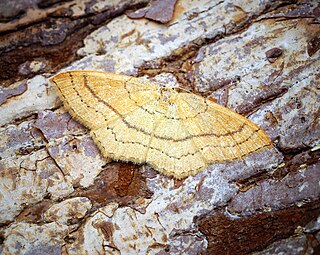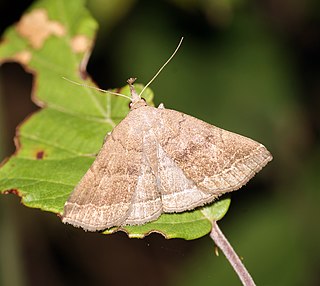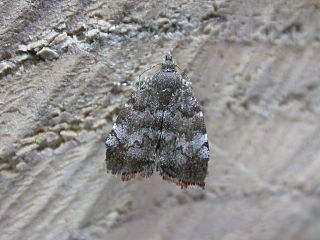
The Tortricidae are a family of moths, commonly known as tortrix moths or leafroller moths, in the order Lepidoptera. This large family has over 11,000 species described, and is the sole member of the superfamily Tortricoidea, although the genus Heliocosma is sometimes placed within this superfamily. Many of these are economically important pests. Olethreutidae is a junior synonym. The typical resting posture is with the wings folded back, producing a rather rounded profile.

The light brown apple moth is a leafroller moth belonging to the lepidopteran family Tortricidae.

Orgyia leucostigma, the white-marked tussock moth, is a moth in the family Erebidae. The species was first described by James Edward Smith in 1797. The caterpillar is very common especially in late summer in eastern North America, extending as far west as Texas, California, and Alberta.

Choreutidae, or metalmark moths, are a family of insects in the lepidopteran order whose relationships have been long disputed. It was placed previously in the superfamily Yponomeutoidea in family Glyphipterigidae and in superfamily Sesioidea. It is now considered to represent its own superfamily. The relationship of the family to the other lineages in the group "Apoditrysia" need a new assessment, especially with new molecular data.

Pandemis heparana, the dark fruit-tree tortrix or apple brown tortrix, is a moth of the family Tortricidae.

Enarmonia formosana, the cherrybark tortrix or cherry-bark moth, is a small but colorful moth species of the family Tortricidae. It is native to all of northern and western Europe, ranging south to the Maghreb. North of the Alps its range extends eastwards to Siberia and Kazakhstan. Possibly and most likely introduced populations are found in Asia Minor and North America, respectively.

Scythropia crataegella, the hawthorn moth, is a species of moth in the monotypic genus Scythropia. It is found in western Eurasia.

Peridroma saucia, the pearly underwing or variegated cutworm, is a moth of the family Noctuidae. The species was first described by Jacob Hübner in 1808. It is found in North and South America, Europe, Asia and Africa. The variegated cutworm feeds on many plants, especially common fruits and vegetables. The moth undergoes two to four generations per year. The development of the moth slows in colder temperatures, indicative of its migratory nature. All stages of the life cycle have a developmental threshold for temperature. The moth is known to migrate to the northern regions during warmer months, returning to the southern regions when the climate becomes colder.

Anthophila fabriciana, also known as the common nettle-tap, is a moth of the family Choreutidae first described in 1767 by Carl Linnaeus. The moth can be found flying around stinging nettles during the day.

Cyclophora linearia, the clay triple-lines, is a moth of the family Geometridae. The species was first described by Jacob Hübner in 1799 and it can be found in Europe and Britain.

Polypogon plumigeralis, the plumed fan-foot, is a species of litter moth of the family Erebidae found in Africa, Asia and Europe. It was first described by the German entomologist Jacob Hübner in 1825.

Lyonetia clerkella, the apple leaf miner, is a moth in the family Lyonetiidae. It is found all over Europe, north-western Siberia, the Far East, northern Africa, the Middle East, Turkey, India and Japan.

Prochoreutis myllerana, Miller’s nettle-tap or small metal-mark, is a moth of the family Choreutidae found in Asia and Europe. Miller's nettle-tap was first described by Johan Christian Fabricius in 1794 from a specimen found in Sweden.
Zodia scintillana is a moth of the family Choreutidae. It is known from Central and South America, including Costa Rica. The habitat consists of tropical rain forests.

Choreutis diana, Diana's choreutis moth, is a moth of the family Choreutidae. It is found in northern North America and most of Europe. It was first described by the German entomologist, Jacob Hübner in 1819.

Choreutis pariana, the apple-and-thorn skeletonizer or apple leaf skeletonizer, is a moth of the family Choreutidae. The moth was first described by the Swedish entomologist Carl Alexander Clerck in 1759. It is native to Eurasia and was introduced to New England, USA in 1917. It was recenly also stated in Korea.

Anthophila threnodes is a moth of the family Choreutidae. It is known from Madeira. The habitat consists of open landscapes at low altitudes.

Choreutis is a genus of moths in the family of metalmark moths (Choreutidae), and therein to subfamily Choreutinae. Of these, it is the type genus. The genus was described by Jacob Hübner in 1825.

Epermenia chaerophyllella, also known as the garden lance-wing, is a moth of the family Epermeniidae first described by Johann August Ephraim Goeze in 1783. It is found in all of Europe and Asia Minor.
Several moth species are known as skeletonizers, including:























